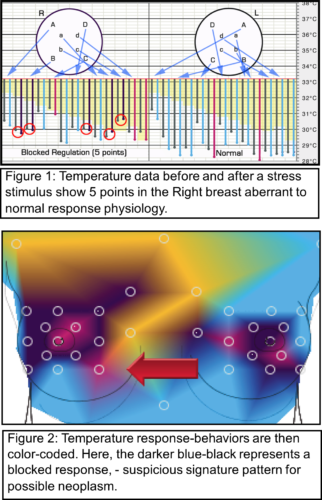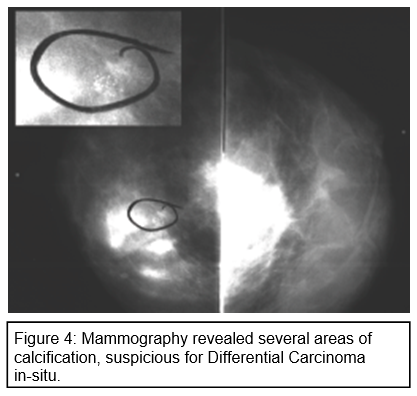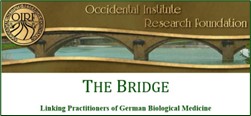Classification of Risk of
Breast Cancer Defined by
Regulation Thermography
Microcalcifications in breast tissue indicate an increased risk for development of certain breast cancers. Studies have proven that abnormal thermal patterns represent a far more reliable risk factor than family history (Gautherie, 1995).
With the advent of Whole-Body Regulation Thermography (AlfaSight 9000, Alfa Thermodiagnostics Inc, USA) patients who have been previously cleared by mammography or had apparently benign fibrocystic mastopathies by history, may show degenerative changes in the neuro-regulative response patterns in the specific breast areas previous to the generation of true identified pathologies.
In screening programs designed to identify women at high risk of developing breast cancer, or in the primary care physician’s office or breast centers, it is apparent that Regulation Thermography should be used routinely in conjunction with all other modalities for screening and diagnosis.
In the primary care setting, a baseline mammographic thermogram should be recorded in all women regardless of age in order to minimize the danger of giving a false sense of security that may result from negative findings from physical or familial investigations alone, and even mammograms. In women above the age of 40, the combination of mammography and thermography can serve to complete the wholistic consideration which includes anatomical as well as functional disturbances.
While the breast cancer rate is rising in women under the age of 45, there has been no non-invasive screening method that makes medical and economic sense. Several studies have demonstrated the effectiveness of a multimodality approach to breast diagnosis based upon complementary techniques. Of the available examination techniques, Regulation Thermography is the only method which observes significant metabolic and vascular phenomena that occur in breast tissue responses to stress. Whereas all other modalities essentially explore breast morphology alone, thermography investigates functional physiology and it’s regulating (homeostatic) mechanisms. The systemic use of thermography in combination with physical examination, mammography and ultrasound increases the overall accuracy of the early detection of cancer by 40% (Gautherie, 1995).
Regulation Thermography adds two additional dimensions to the diagnostic richness of the test:
- It measures autonomic response seen as projections through the viscera and tissues; and
- It utilizes and describes signatures of disease-patterns as it has been synthesized by over 35 years of clinical case studies confirmed by pathology and radiological findings, incorporated into Alfa’s computerized workstation software.
Case Study
A 42 year-old women came to the clinic with fibrocystic breasts, negative mammography 9 months prior. Regulation Thermography results: marked rigid (blocked) regulation in the right breast (Figure 1). However Regulation Thermography is significantly more comprehensive in the fact that distant body points that link to the organ under evaluation play a direct role in the determination of suspicion. In the case of breast cancer, the lymph system as well as the endocrine system play additional roles in shaping some of the predisposing factors to neoplastic conditions. In this patient, both the alarm-point sternum was blocked, as well as 60% of the lymph points (neck).


After a clear suspicion was clarified by the Alfa system, along with references to possible concomitant abnormalities such as possible infections or endocrine imbalances, the patient was referred to mammography for a second time in one year.

Mammography revealed calcifications evident for Differential Carcinoma in-situ. Biopsy revealed positive for ductile carcinoma.
Conclusion
Thermography can sometimes visualize abnormalities in blood flow physiology that may not be seen in other imaging methods. Infrared camera methods fall short of potential avenues of biophysical information that can be seen and carefully analyzed by the method of Regulation Thermography. By utilizing mathematically-analyzed temperature behaviors, blockages and characteristics of homeostatic abnormalities can be seen. Regulation Thermography has had a history that has allowed hundreds of thousands of patients to be evaluated with clinically-verified medical conditions including diabetes, heart disease, immune disorders, neurological disorders, and various cancers. The AlfaSight 9000 method ([email protected]) is an updated system derived directly from the historically proven and validated methods.
 An Exclusive Article for OIRF Supporters
An Exclusive Article for OIRF Supporters
From THE BRIDGE Newsletter of OIRF
Published September 2016
© Copyright 2013, Dr. Dan Beilin, California USA
References:
- Beuth, J; Complementary Oncology, 2012, Thieme Verlag
- Vitteta, Luis et.al. 2010, Contact Regulation Thermography. Swinborne Univ.
- Blum, P 2005; Regulation Thermography. Textbook.Archimedes Press
- Beilin, D. 2011; Regulation: An extended paradigm. Lecture, Baden-Baden Medicine Week



